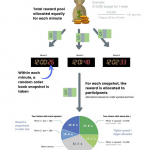Copenhagen-based startup Media Sifter is looking to transform the news media industry using blockchain technology and the wisdom of the crowd.
Media Sifter’s news aggregator, which is set to be launched in alpha in October, will be built on top of a community that validates aggregated content through blockchain-powered user consensus, enabling users to better “navigate through the noise and bias of the current media landscape.”

“The advent of the internet has led to a soar in publications, generating lots of good content but also a lot of noise. Excessive amounts of time are required today to critically consume news,” Ezequiel Djeredjian, Media Sifter’s communications lead, told CoinJournal. “In addition, the attention economy business model that pays for clicks rather than quality content, plus biased and agenda driven journalism has caused historical lows on readers’ trust on media.”
Media Sifter aims to solve these issues by utilizing the crowd to investigate anyone’s content, and allow people to access multiple opinions on any story.
Media Sifter will pay for contribution and reward users who bring evidence to back up claims on the platform. The platform will also be censorship resilient.
Media Sifter started in 2015 at the Copenhagen Institute of Interaction Design by CEO and founder John Ferreira while investigating how one could prevent misinformation and disinformation in the media. Unable to find a solution that solved this problem, Ferreira decided to build his own platform that would help him and others consume news more critically.
Djeredjian said that unlike competitors who revolve around content creation, Media Sifter solely focuses on aggregating existing content and puts a “community-driven layer on top.” This approach not only allows users to consume content from day one, it also enables them to keep on reading their usual sources of information without having to go out of their way to be sure what they are reading is fact-checked.
“Our focus is on providing users with difference of opinion, giving them the tools to investigate the content they consume and tap into the knowledge of the community while rewarding contribution,” he said.
Consolidation in the media industry has resulted in the centralization of influence. In the US, for instance, six corporations currently control 90% of the media, according to research conducted by the University of East Anglia.
In an industry that’s owned by a handful of large firms, the potential of blockchain lies in its ability to create platforms that are owned and governed by consumers, Djeredjian said.
“Ownership by users also represents an opportunity to counter the ‘free’/ad-funded business model that is currently prevailing in the industry, as the community directly benefits from the platform’s long-term success,” he added.
“On the content-side, the blockchain’s core principles allow for increased trust. There is no more central entity that can enforce its agenda or bias on its readers, as the content creation process is driven by user-consensus.
“Moreover, distributed content is also hack- and censorship-resilient and benefits from increased transparency.”
Following its alpha release next month, Media Sifter will launch a simulated version of its SIFT Protocol, a decentralized and self-governing network. The company plans to have a version 1.0 of the platform live by Q3’18 including the SIFT Protocol on the Ethereum live network.










